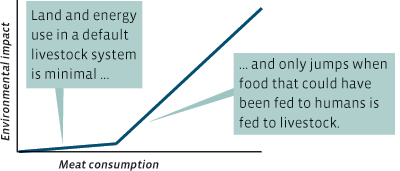The Animals Issue:
- Just the Facts: Should We Eat Animals?
- Share

Just the Facts: Should We Eat Animals?
We can feed the world and still eat meat—but only a little bit.
We lose nutrition when we feed grain to animals.
 Estimates vary, but it takes around 10 units of grain to produce 1 unit of beef … |
 … and about 4 units of grain to produce 1 unit of pork. |
If humans ate the grain instead, we could eliminate world hunger.

As of 2000, 18% of the world’s population was undernourished and underweight, while 35% of global cereal production was being fed to livestock.
But that doesn’t mean we can’t eat meat.

“Default livestock” only eat food that humans can’t or won’t eat, the way it’s done in much of the world—and in permaculture. If we raised all livestock that way, we’d end up with more food.
Default livestock use minimal land and energy.
A 2006 study of Dutch food consumption—which is similar to other Western diets—found that if the Netherlands relied solely on default livestock, each citizen could eat about 27 grams of pork protein a day—about one pork chop.

We can feed everyone and still eat meat. But only a little.
Researcher Simon Fairlie estimates that a worldwide default livestock system would provide the equivalent of three cheeseburgers a week for everyone on the planet—and free up enough cropland so no one would go hungry.

Sources:
Many of the concepts in Just the Facts were derived from researcher Simon Fairlie’s book (2010, Permanent Publications).
1) The nutrition ratios given are loose averages of figures quoted by Fairlie. For example, In Diet for a Small Planet (1991, Ballantine Books), Frances Moore Lappé gives a grain to beef energy ratio of 21:1. In “Animal Agriculture and Global Food Supply” (1998), the Council for Agricultural Science and Technology reports grain to meat weight ratios of 2.6:1 for beef, and 3.7:1 for pork in developed countries, a figure that is meant to reflect a lifetime diet that includes grass, forage, and byproducts as well as grain. Fairlie derives purely grain-fed protein ratios of 12.5:1 for beef and 5.25:1 for pork from the same CAST document, before accounting for non-grain feed and calculating a new protein ratio for beef of 3.2:1. Ratios compiled by Fairlie range from 1.4:1 to 21:1 for beef and from 3.7:1 to 5.5:1 for pork.
2) The Worldwatch Institute, “Eradicating Hunger: A Growing Challenge,” 2001, pp. 43, 59, State of the World 2001.
4) E.V. Elferink, S. Nonhebel, H.C. Moll, “Feeding livestock food residue and the consequences for the environmental impact of meat.” Journal of Cleaner Production, Volume 16, Issue 12, pg. 1227-1233, 2008
5) Simon Fairlie, , 2010, Permanent Publications. Pg. 39.

